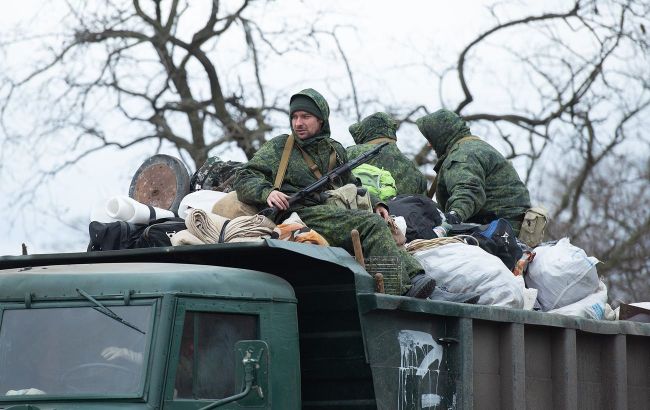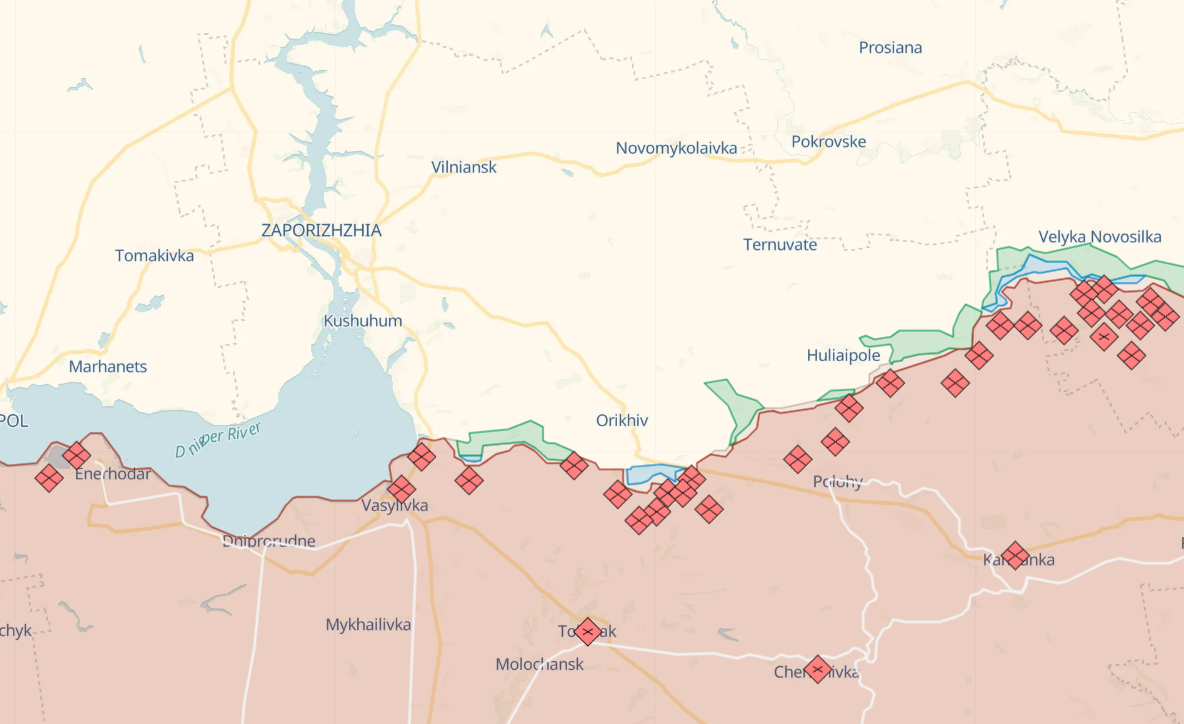Russians flee Ukraine’s occupied territories amid fears of counteroffensive
 Russians flee Ukraine’s occupied territories amid fears of counteroffensive (Getty Images)
Russians flee Ukraine’s occupied territories amid fears of counteroffensive (Getty Images)
Occupation authorities (gauleiters) of the Russian-seized Ukrainian territories have begun evacuation in the Zaporizhzhia region. Local residents and community leaders report that the Russians shut down some of their administrations and services in the Kherson region as well. An article by RBC-Ukraine explains whether the occupiers are really preparing to retreat from the south of Ukraine.
The events and moods that have been spreading among the occupiers since the beginning of May can be described by the ironic phrase "There is no panic" (a phrase often used by Russian propagandist media). At the end of last week, Russian military commanders supporting the Kremlin regime were literally racing to announce the beginning of the Ukrainian offensive and the direction of the attack.
Some Russians argued that the Ukrainian Armed Forces would move from Mayorsk toward Horlivka, which had been captured in 2014. Others claimed that the Ukrainian army was moving from Vuhledar. Other Russian "analysts" stated that Ukrainian troops would move to Belgorod or Luhansk regions. Still, others complained that the Defense Forces had begun to encircle Bakhmut, attacking the enemy group from the flanks. At the same time, it was reported in Russian social media that Ukraine was allegedly amassing forces near Orikhiv and Huliaipole, as well as boats in Beryslav to cross the Dnipro River.
 (deepstatemap.live)
(deepstatemap.live)
There is some truth in all these reports. There has indeed been an improvement at the front in recent weeks. Ukrainian troops have been actively destroying enemy rear areas, warehouses and logistics, as well as conducting reconnaissance by combat in various areas. Localized attacks and concentration of forces in different areas are aimed at confusing the enemy as to where the main attack will be made. All of this is called the formation of the battlefield before Ukraine's upcoming offensive.
The Russians believe that its main focus will be a breakthrough to the Azov Sea in Zaporizhzhia. The possibility of such an operation has been discussed in the media and among experts for several months. The occupiers have been building a huge network of trenches, ditches, barricades and minefields since November last year to protect their so-called land corridor to Crimea. However, the Russians and local collaborators seem to be unsure of the extent to which this will stop the Ukrainian army.
In early May, they began evacuating civilians in the Zaporizhzhia region. The last time the occupiers conducted such an "evacuation", enemy troops and equipment were gradually withdrawn from the right-bank Kherson region under the cover of civilians. Are the Russians preparing another "goodwill gesture" and "difficult decision" in the south?
"There is no panic"
On May 5, a representative of the occupation authorities of the seized part of the Zaporizhzhia region, Yevhen Balytskyy, announced that there is a plan to evacuate residents from 18 settlements located near the contact line. In total, it is about more than 70 thousand people.
In some places, the "evacuation" is voluntary, in others, it is forced. People are intimidated by the escalation of hostilities or promised 10.000 rubles after leaving, although the gauleiters keep silent about the fact that such assistance is provided only for Russian passport holders.
Moreover, Balytskyy assured that despite the evacuation, "there is no panic." Although the whole process is accompanied by an atmosphere of complete disorganization and chaos. There is a shortage of fuel at gas stations, stores are running out of food, and ATMs are running out of cash. According to the head of Zaporizhzhia Regional Military Administration, Yuriy Malashko, the occupiers are deliberately not delivering food in order to force local residents to leave.
"At first, the Russians took people only to Berdiansk and Kyrylivka. Then they realized that they could not launch anything in Kyrylivka, because everything there has been closed for more than a year. So, they started taking people to Berdiansk, Rostov and Dagestan. But we know of cases when our people were allegedly taken to Berdiansk, but in the end they were taken to Rostov, where they were placed in tent camps," the mayor of occupied Melitopol Ivan Fedorov told RBC-Ukraine.
Furthermore, the head of the Zaporizhzhia Regional Military Administration stated that the gauleiters said that an offensive by Ukrainian forces was about to take place and relocated some of the residents to Berdiansk. However, there they actually found themselves left to their own devices, without any conditions or means of subsistence, and so people had to return home on their own.
"We also have information that the Russian military settled in the homes of those who were evacuated and simply looting and pillaging - they probably lack toilets," the head of the Zaporizhzhia Regional Military Administration said in an interview.
The mayor of Melitopol added that the Russian evacuation has already effectively failed, as the civilian population mostly refuses to leave. According to his estimates, the number of those who agreed to leave by buses organized by the gauleiters is measured in only hundreds of people.
"On the other hand, we saw that people who came from mainland Russia and settled in Melitopol in seized houses and apartments actually left on the first day of the evacuation, despite the fact that the evacuation of Melitopol was not announced," the mayor of the city noted.
Collaborators and those who voluntarily received Russian passports are much more willing to leave. According to Malashko, they are fleeing either to Crimea or through the Donetsk region to Russia.
"The departures are mostly from large cities - Enerhodar, Melitopol, Berdiansk. The Russians realize that the de-occupation of these territories is imminent, so they are doing something to protect their own," the head of the region said.
According to Ukraine’s Defence Intelligence, occupation authorities are taking with them everything valuable that they can transport: cars, equipment, household appliances and important documents. For example, in the village of Vesele, Melitopol district, local "police" simply closed the police station and burned all the documents. The same event happened in Melitopol’s "passport office" and in the so-called "military service," Fedorov said.
The situation in Enerhodar is the most illustrative in this regard, where the Russians are even taking out medical equipment and sending patients to the Melitopol hospital. The city has no stationary Internet, no "administrative services" and a large number of pharmacies. There is a rush for essential goods.
"The staff of Zaporizhzhia Nuclear Power Plant is also being taken out of Enerhodar. But we are talking about people who either consciously worked for them or were forced to work for them. They are told that fighting will soon begin there, that the area will allegedly be shelled and bombed, so they are persuaded to leave and continue working with the Russians", a representative of the Defense Intelligence Andriy Chernyak told RBC-Ukraine.
In general, in the future, we can talk about the "evacuation" of about three thousand employees who signed a contract with the occupation structure "Operating Organization of Zaporizhzhia NPP" or directly with Rosatom. ZNPP itself was shut down in September last year.
Zaporizhzhia NPP is not working in Enerhodar, we are feeding it from the Ukrainian power grids. There is some information that the occupiers are taking some documentation from there. And the territory of the plant is mostly used as a warehouse for weapons and heavy equipment. We also received information that Russian personnel were taken out of the station. At the same time, the IAEA representatives are now there, working and providing relevant reports," Malashko explained.
Preparing for combat
A similar "Brownian motion" is taking place in the territory of the Kherson region, which is still controlled by the Russians. Interlocutors in military circles say that the information that Ukrainian forces have taken up positions in the region on the left bank of the Dnipro River is not true. Ukrainian presence there is still limited to the raids of the Special Forces. However, the General Staff of the Armed Forces reported that the week before last, the Russians had already begun to wind down the activities of some of their "administrations," in particular in Skadovsk.
"There is also evidence that in Hola Prystan the Russians have begun to take out equipment from hospitals, documents, equipment and furniture from the regional road department, and everything from the fisheries department is also being taken out. There is a constant movement of both collaborators and Russian FSB officers through Henichesk toward Crimea. There are big traffic jams on Chongar itself. However, we have not yet observed an organized mass evacuation of civilians," Kherson Regional Military Administration spokesman Oleksandr Tolokonnikov told.
It is unlikely that the Russians are really concerned about the fate of the civilian population of the occupied territories. This can be seen in the example of the residents' evacuation on the right bank of the Kherson region. As they were simply used as human shields last year. Now the occupiers are also pursuing several goals with this "evacuation", but they are not related to the withdrawal of troops.
"They place our people in Berdyansk, where they also place the military. So they are hiding behind our people. Secondly, today we see that when residents leave for evacuation, Russians immediately enter and start looting. The third goal is to show their propaganda that they seem to care about the residents of the occupied territories," the mayor of Melitopol said.
At the same time, the Defence Intelligence of the Ministry of Defense of Ukraine notes that under the guise of the so-called evacuation of civilians, Russians are actually conducting counterintelligence and filtration activities in the areas where they believe active hostilities will soon take place.
"First of all, they don't want the population to be able to observe their preparations for combat, so these are certain counterintelligence measures. It is also a filtration measure since the first thing they do is to force the deportation of the pro-Ukrainian population. And thirdly, the Russians are afraid of some kind of guerrilla movement and internal resistance in these territories," Chernyak explained.
However, the Intelligence has not yet recorded the withdrawal of Russian combat units from either the Zaporizhzhia or Kherson regions. According to Chernyak, approximately 152,000 enemy troops are currently concentrated in the occupied territories of these two regions. And all their actions indicate that they are preparing for defense.
This is especially evident in the area of Melitopol, around which the enemy has built an extensive system of defensive lines. The city is located on a route that connects Russian troops from the left bank of the Dnipro to Mariupol. Therefore, the loss of Melitopol, on the one hand, will cut off the supply of the occupation group in the south. On the other hand, it will open the way for Ukrainian troops to Perekop and Chongar, which is the gateway to Crimea.
In such a scenario, the Russian contingent on the left bank of the Kherson region and in the Melitopol direction will be virtually semi-encircled and forced to retreat to the peninsula. However, if another incident occurs with the Kerch Bridge, this will not be the best way to retreat. Obviously, the local collaborators do not consider these events to be distant prospects, if they have already decided to run away.

